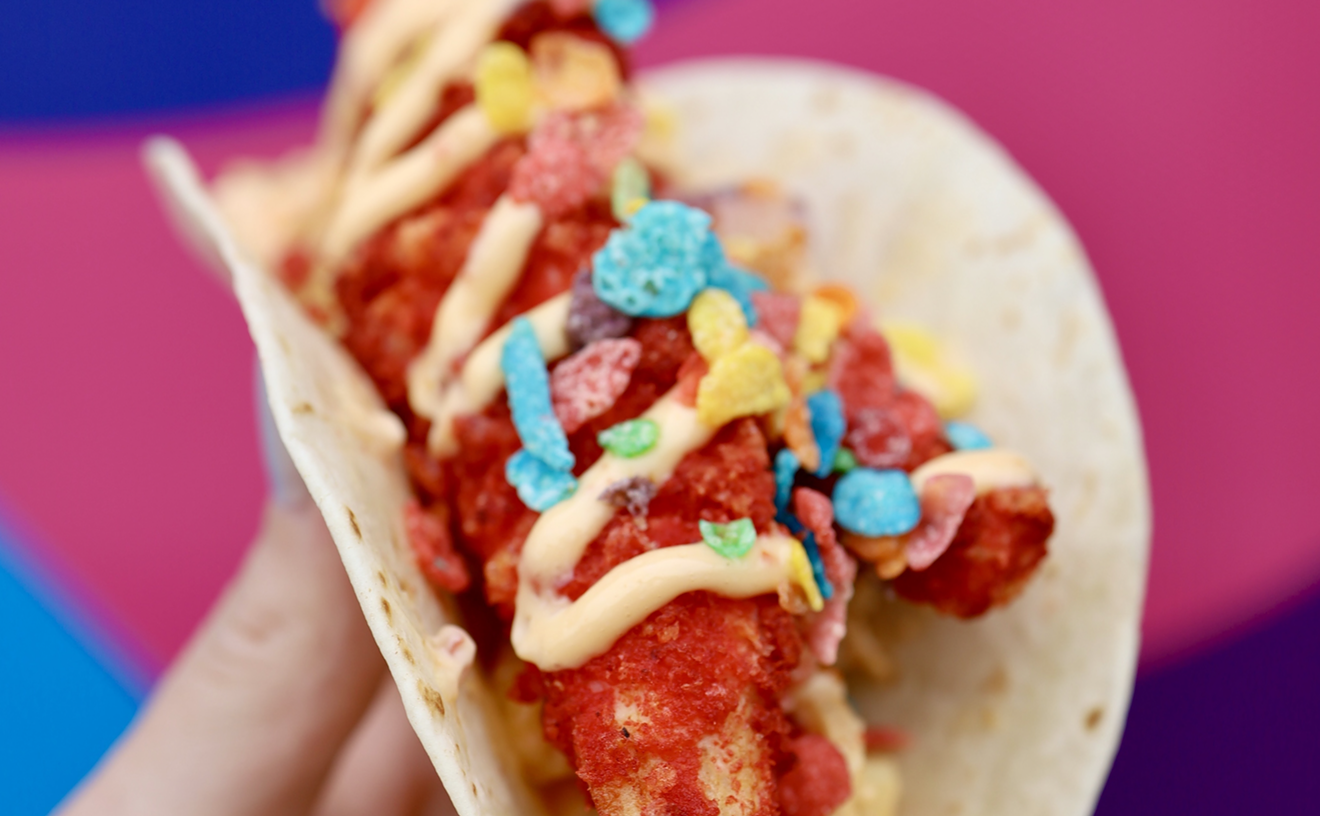It's not easy to pinpoint the exact difference between fusion and global cuisines, since both combine influences from regions all over the world. To keep it simple, though, in an eatery specializing in fusion, you'd be likely to find multinational ingredients and techniques in each dish -- say, spring rolls stuffed with Latin-style roast pork and melted Brie, as well as the usual Asian veggies. In a global restaurant, the menu may reflect just as many nations, but as an international smorgasbord: Chinese spring rolls, Cuban pan con lechon, a French cheese plate. Last year, when a South Beach restaurant opened with a menu that featured Mayan tacos and sushi, I thought Miami had pushed the global cuisine envelope about as far as it could go.
I was wrong. At this past February's South Beach Wine & Food Festival I came across a restaurant booth that demonstrated how limited my imagination had been. The restaurant was a brand-new place called Guru. As the name would suggest, there were several Indian dishes on the menu. But the house special was "signature lasagna" with chicken piccata and garlic pesto toast. Other featured items included Japanese steak, Cajun blackened salmon, Polynesian plum pork, caesar salad (a dish reportedly invented in Tijuana, Mexico), Thailand's classic pad thai, and a "soul plate" with homemade meat loaf, mashed potatoes, and mushroom gravy. In rounding up dining companions, I found myself explaining, "Oh, it's sorta your basic Indian-Hawaiian-Italian-Deep South-Japanese-New Orleans-Thai cheeseburger joint."
In recent months, the meat loaf and lasagna have disappeared from the menu. But happily for Beach dwellers, who have no other source for an Indian food fix, Guru's true signature specialties from proprietor Adish Jain's native country have been increased to fifteen offerings. Additionally the original New York-style Sunday brunch has been changed to an Indian buffet of a half-dozen entrées, plus green and tropical fruit salads. The $9.95 price tag seemed an especially good deal considering Guru's minimalist California-casual setting. With nary a flocked Taj Mahal mural or kitschy ceramic elephant in sight, the décor makes Guru much more suited to a budget business brunch than typical Indian eateries.
Sampling small portions of this and that at dinnertime is more difficult than at typical Indian restaurants because entrées are served Western-style -- that is, each item comes on a plate garnished with a starch and salad intended for a single person, rather than in family-style serving bowls conducive to sharing. Persevere, as my parties did on three visits, and Guru's friendly servers will bring empty plates that enable diners to divvy up the bounty, if awkwardly. This you will want to do despite the embarrassment of spilled rice and julienned salad veggies all over the tabletop. After all, who'd want to stick to your own individual mountain of nilgiri korma when Guru's mattar paneer, chicken makhani, and kofta curry are equally delicious?
All were also quite rich, making a quarter-portion of each entrée about all a single diner could handle without a change of pace. The tender braised beef in the korma came in a gravy of ground nuts and yogurt intensely spiced with garam masala, bold enough to make the most savory French boeuf bourguignon seem like baby food. The mattar paneer (a popular Punjabi dish whose main ingredients are peas and squares of fresh cheese made from yogurt or tofu) provided an effective vegetable contrast to the beef stew, particularly because the peas were not overcooked as they are in many Indian restaurants. The tomato-based sauce, however, was unusually sweet and much creamier than normal, which meant that a little went a long way.
The same was true of chicken makhani, as could be expected from the name. Makhani is butter, and cream also figures in this recipe. But despite the skinless (and somewhat dry) chicken chunks, it was not a diet dish. It was very good, though, balanced by alternating mouthfuls of palak paneer (spinach and tofu cheese). While I personally prefer palak with the leaves left intact enough to provide some crunch, Guru's smooth purée did taste like fresh, not canned, spinach. And ginger gave this comfort food a little zing.
Goan fish curry was disappointing. The fillets of white fish, delicate to begin with, had been cooked so long they fell into dry flakes at the touch of a fork. A coconut curry sauce was far too sweet, and otherwise bland. The curry might well have pleased diners who slog through dinner mainly to get to dessert. But my party of culinary heat-seekers was bored; they'd been hoping for the chili fire that is a specialty of this southwestern Indian state.
Vegetarian items were a strong point, particularly dal makhani. Although the word dal covers the full range of legumes (chickpeas, beans, a vast variety of lentils), the dals served as sides at many Indian eateries are most often thin, one-dimensional gruels. Guru's dal dish, by contrast, had a meaty heft. Overnight stewing had dissolved some of the gram lentils into a heavy, creamlike sauce, while others retained enough body and chewiness to give the entrée considerable textural variety.
Meat was also not missed in kofta curry, vegetarian dumplings in a mild, thick, yogurt-based gravy. Vegetable "meatballs" tend to be too uniform in texture; additionally, when bound with potato (as they often are) they can be oppressively heavy. But Guru's dumplings were airy, tender, and thanks to the inclusion of whole and diced mixed vegetables, interesting.
All meals come with a bhajia (fried vegetable fritter), little bowls of mint and tamarind dipping sauces, and a complimentary starter of nan flatbread strips with cucumber raita. An entrée per person is plenty of food. Still the masala pappadam appetizer is a good additional choice -- if you eat it fast. Instead of being served on the side, a diced tomato/onion salsa was served as a topping. This looked great, and provided a refreshing counter to the pappadams' chili-spiked savor. But it also totally saturated the paper-thin fried crisps within ten minutes, making them about as appealing as melted-down communion wafers.
To accompany food, there are some reasonably priced Western world wines, though neither a large nor interesting enough selection to justify the "wine bar" in Guru's moniker. Best stick to frosty Kingfisher Indian beer (at four dollars it's priced the same as domestic brew) or to mango lassi. The latter was rich and sweet enough to substitute for dessert. But desserts were actually quite good, especially a version of traditional gulab jamun that replaced the standard sugar syrup in which these rosewater-flavored Indian pastry balls are usually soaking with much less cloying, whipped cream-topped vanilla ice cream. A Latina friend found Guru's kheer (rice custard with cashews and saffron) better than her mom's Cuban rice pudding.
Incidentally, trend-minded diners will be relieved to know that though the lasagna and meat loaf are history, Indonesian lemon fish and Argentine churrasco steak have been added to Guru's still strange list of non-Indian "international" entrées. So Miami hasn't lost its global-cuisine competitive edge. More evidence: The intensely Indian-spiced French fries accompanying the American cheeseburger were terrific.










